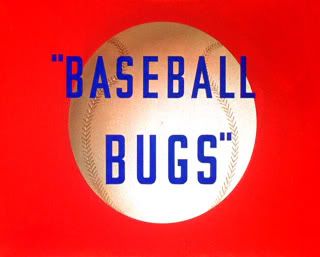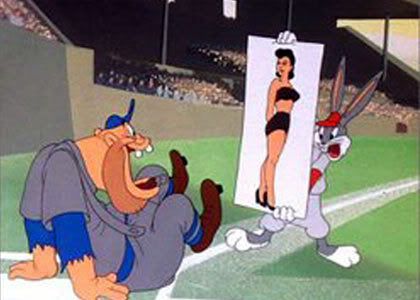
Baseball Bugs is a Warner Brothers Looney Tunes theatrical cartoon short released on February 2, 1946 starring Bugs Bunny. It had a similar theme to MGM's 1944 Batty Baseball, which was directed by former WB cartoon director Tex Avery.
Baseball Bugs was directed by Friz Freleng and written by Michael Maltese. Hawley Pratt and Paul Julian did the layout and backgrounds, while Manuel Perez, Ken Champin, Virgil Ross and Gerry Chiniquy headed the team of animators. Mel Blanc provided voice characterizations, with a cameo by Bea Benaderet as Lady Liberty and the screaming baseball, and Frank Graham uncredited as the stadium announcer and several of the Gas-House Gorillas. Carl W. Stalling was the music director.

The cartoon's title is a double play on words. "Bugs" was then a common nickname for someone who was considered to be crazy, erratic, or fanatical. In addition to its adjective form being the indirect inspiration for the Bunny's name, the noun form was sometimes applied to sports fans.

In keeping with the cartoon's wackiness, certain anomalies are evident to the close observer, starting with the fact that the title card looks more like a softball than a baseball.
Instead of Porky Pig and "That's all, folks!", the cartoon ends with one of Bugs' rare closing appearances, popping through a drum, munching a carrot, announcing, "And dat's de end!".
This version of the drum was also seen on the previous cartoon, Hare Tonic.

# Factual errors: The home team is shown batting at the top of the inning.
# Factual errors: Halfway through the cartoon, the scoreboard shows the Gas-House Gorillas after four innings with the following scores: 10 + 28 + 16 + 42 for a total of 96 points. Yet, in the bottom of the ninth, the emcee gives the score as "Gas-House Gorillas: 95 points. Bugs Bunny: 96."
What do the signs behind Bugs say as he boos the visiting team?
"Cough your heart's content" (a cigarette ad? cough drops?) | "Maltese: Ace Dick" (a reference to the writer of this cartoon, Michael Maltese) | "NOZ: 2 for 25" | "Filboid Studge"
What do the signs behind Bugs say when he first starts pitching?
"Manza Champagne" | "Lausbub's Bread." | "Finer Footwear: Ross Co."
I don't get the Statue of Liberty joke.
Bugs is forced to take an elevator to the top of the Umpire (!) State building to catch a fly ball. The umpire and the guy who hit the ball follow him. Bugs catches it, and the umpire calls the guy out.
"Out?" the player protests.
The Statue of Liberty intervenes and with rapid-fire delivery, says, "That's what the man said, you heard what he said, he said that!"
Bea Benaderet, as the voice of Lady Liberty, is imitating the typical woman fan of the day. Audiences would have immediately recognized the type from their own experience and would have been surprised, and delighted, to hear the familiar speech patterns coming from the mouth of Lady Liberty. It's also possible that this stereotype was already filtered through a familiar radio character. In that case, the gag would invoke both the real-life type and the radio character that crystallized the type in the public's mind.
"Does your tobacco taste different lately?"
When a Gas-house Gorilla hits the wall, there's a sign behind him that says, "Does your tobacco taste different lately?"
[T]here's a fascinating story about the sign and its impact on baseball players in the 1945-'46 season. Now, most people today don't know this, but the slogan 'Does Your Tobacco Taste Different Lately?' was the slogan of Sir Walter Raleigh pipe tobacco, manufactured by the Brown & Williamson Tobacco Company. Even though tobacco products were in short supply during and shortly after the end of the Second World War, Brown & Williamson wanted to a) remind people that they were still in the tobacco business; and b) there seemed to be a lack of sales of Sir Walter Raleigh among professional ball players. So, in addition to their slogan being read in newspapers and magazines and heard on Raleigh's sponsored radio shows, B & W got the bright idea of mounting this slogan on the walls of 14 major ball parks (including the Polo Grounds) across the United States, and made sure that, whenever a ball player hit the wall with their slogan on it, the dazed player would look up at the words, 'Does Your Tobacco Taste Different Lately?', and slowly realize that it DID. Sales of Sir Walter Raleigh soared during the 1945-'46 season among professional baseball players...even those who DIDN'T smoke pipes!
Three-and-a-half years old
The following films have a character who says, "I'm only three-and-a-half years old!," a reference to the catchphrase of Lou Costello.
Falling Hare (1943). Bugs Bunny gets hit in the head with a wrench and babbles that he's only three-and-a-half years old.
Baseball Bugs (1946). Variation: A baseball player from the home team, the Tea Totallers, says, "I'm only ninety-three-and-a-half years old!"
Big House Bunny (1950). Variation: Sam is a prison guard who refers to Bugs by his number: 777174. Bugs claims he's only three-and-a-half.
Among the ads on the fence is one for "Mike Maltese, Ace Detective" featuring a picture of Michael Maltese (the writer of "Baseball Bugs") with a fedora and a pistol.

1 comment:
The "that's what the man said" bit was used a number of times by Rochester on the Jack Benny Show. Whether Benny's writers were referencing something else, I don't know.
Post a Comment